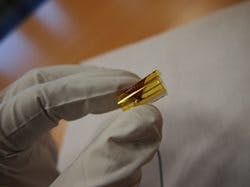Optical circuits have bendable--and stretchable--interconnections
Washington, DC--A paper published in Optics Express entitled "Stretchable optical waveguides" reports progress from a team of Belgian researchers on what may be the first optical circuit that uses interconnections that are not only bendable, but also stretchable. These new interconnections, made of a rubbery transparent material called PDMS (polydimethylsiloxane), guide light along their path even when stretched up to 30% and when bent around an object the diameter of a human finger--useful attributes for futuristic applications like wearable body sensors and robotic skin.
Furthermore, by integrating these stretchy interconnections into a circuit with a light source on one end and a detector on the other, the researchers created a miniature stretchable, bendable "link" that could be incorporated into optical communications systems. "To our knowledge, this is indeed the first truly bendable, stretchable optical link with these miniature dimensions," said lead author Jeroen Missinne of Ghent University and the imec micro- and nano-electronics research center.
Previously, researchers had created optical interconnections--also called lightguides or waveguides--from other similar rubbery materials. But until now, the researchers say, no one had discovered a way to enable these materials to carry light while stretched. Past efforts also included embedding waveguides made of semi-rigid glass fibers into a stretchable substance. In the new method, the stretchable substance itself is the waveguide.
The new connector consists of two materials, both made of PDMS: a transparent core through which the light travels, surrounded by another transparent layer of PDMS with a lower refractive index, a characteristic of the material that describes how light moves through it. This configuration traps light in the guide’s core, causing it to propagate along its length.
"We were surprised that stretching had so little influence on the waveguides and also that their mechanical performance was so good," Missinne said. The guide's reliability was also "remarkable," he said. The researchers did not see a degradation in the material even after mechanically stretching it to a 10 percent elongation 80,000 times.
But, Missinne said, "Waveguides are useless if you cannot launch light into them and collect light on the other end. If you want to obtain a truly stretchable optical link, the light sources and detectors need to be integrated together with the stretchable waveguide." In this case, a VCSEL (vertical-cavity surface-emitting laser), commonly used for fiber-optic communications, served as the light source, and a photodiode was the detector. This configuration allowed the team to create the first truly stretchable optical interconnector.
Future uses for the new optical link might include building networks of wearable body sensors, moving machine parts such as robotic limbs, and deformable consumer electronics. Meanwhile, the team plans to make their waveguide smaller, down from 50 micrometers to just a few micrometers in diameter, which will also require a redesign of the parts of the waveguide where light enters and exits.
SOURCE: OSA; http://www.osa.org/en-us/about_osa/newsroom/newsreleases/2014/a_stretchable_highway_for_light/

Gail Overton | Senior Editor (2004-2020)
Gail has more than 30 years of engineering, marketing, product management, and editorial experience in the photonics and optical communications industry. Before joining the staff at Laser Focus World in 2004, she held many product management and product marketing roles in the fiber-optics industry, most notably at Hughes (El Segundo, CA), GTE Labs (Waltham, MA), Corning (Corning, NY), Photon Kinetics (Beaverton, OR), and Newport Corporation (Irvine, CA). During her marketing career, Gail published articles in WDM Solutions and Sensors magazine and traveled internationally to conduct product and sales training. Gail received her BS degree in physics, with an emphasis in optics, from San Diego State University in San Diego, CA in May 1986.
